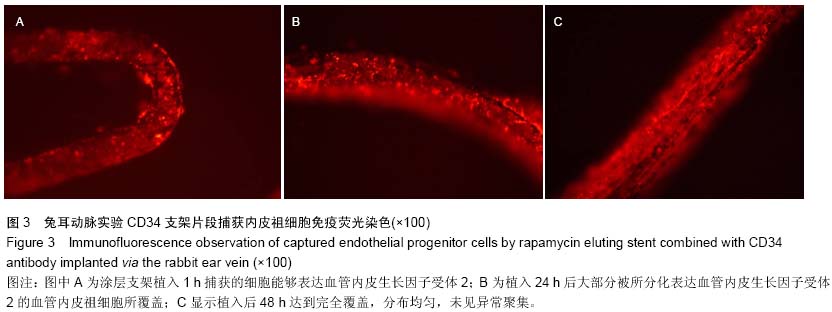| [1] Williams DO, Holubkov R, Yeh W, et al. Percutaneous coronary intervention in the current era compared with 1985-1986: the National Heart, Lung, and Blood Institute Registries.Circulation. 2000;102(24):2945-2951.
[2] Ardissino D, Cavallini C, Bramucci E, et al. Sirolimus-eluting vs uncoated stents for prevention of restenosis in small coronary arteries: a randomized trial. JAMA. 2004;292(22): 2727-2734.
[3] Carter AJ, Aggarwal M, Kopia GA, et al. Long-term effects of polymer-based, slow-release, sirolimus-eluting stents in a porcine coronary model. Cardiovasc Res. 2004;63(4): 617-624.
[4] Pfisterer M, Brunner-La Rocca HP, Buser PT, et al. Late clinical events after clopidogrel discontinuation may limit the benefit of drug-eluting stents: an observational study of drug-eluting versus bare-metal stents. J Am Coll Cardiol. 2006;48(12):2584-2591.
[5] Nordmann AJ, Briel M, Bucher HC. Mortality in randomized controlled trials comparing drug-eluting vs. bare metal stents in coronary artery disease: a meta-analysis. Eur Heart J. 2006;27(23):2784-2814.
[6] Camenzind E, Steg PG, Wijns W. Stent thrombosis late after implantation of first-generation drug-eluting stents: a cause for concern. Circulation. 2007;115(11):1440-1455.
[7] Joner M, Finn AV, Farb A, et al. Pathology of drug-eluting stents in humans: delayed healing and late thrombotic risk. J Am Coll Cardiol. 2006;48(1):193-202.
[8] Kong D, Melo LG, Mangi AA, et al. Enhanced inhibition of neointimal hyperplasia by genetically engineered endothelial progenitor cells. Circulation. 2004;109(14):1769-1775.
[9] 谭强,邱录贵,李广平,等.循环早期内皮祖细胞与外向生长内皮细胞在血管新生中的作用[J].中华高血压杂志,2010,18(7): 658-664.
[10] Kutryk MJ, Kuliszewski MA. In vivo endothelial progenitor cell seeding of stented Arterial segments and vascular grafts. Circulation. 2003; 108(suppl IV): IV-573.
[11] Schober A, Hoffmann R, Oprée N, et al. Peripheral CD34+ cells and the risk of in-stent restenosis in patients with coronary heart disease. Am J Cardiol. 2005;96(8):1116-1122.
[12] Berger J, Reist M, Mayer JM, et al. Structure and interactions in chitosan hydrogels formed by complexation or aggregation for biomedical applications. Eur J Pharm Biopharm. 2004; 57(1):35-52.
[13] Ueno H, Mori T, Fujinaga T. Topical formulations and wound healing applications of chitosan. Adv Drug Deliv Rev. 2001; 52(2):105-115.
[14] 尹青令,侯宁宁,崔晓栋,等.聚乳酸防粘连膜对晚期内皮祖细胞功能的影响[J].功能材料,2014,45(3):3101-3105.
[15] Hristov M, Weber C. Endothelial progenitor cells in vascular repair and remodeling. Pharmacol Res. 2008;58(2):148-151.
[16] 崔斌,黄岚,宋耀明,等. 冠心病患者循环内皮祖细胞与相关危险因素及冠状动脉病变的关系[J].中华心血管病杂志,2013,33(9): 785-788.
[17] 张峰,郭伟,余占江,等. 对用于包被冠状动脉支架的抗CD34单克隆抗体的生物学指标的质量控制研究[J].药物分析杂志,2011, 31(5):862-866.
[18] Rodriguez AE. Emerging drugs for coronary restenosis: the role of systemic oral agents the in stent era. Expert Opin Emerg Drugs. 2009;14(4):561-576.
[19] Celik T, Iyisoy A, Kursaklioglu H,et al. The forgotten player of in-stent restenosis: endothelial dysfunction. Int J Cardiol. 2008;126(3):443-444.
[20] Joner M, Finn AV, Farb A, et al. Pathology of drug-eluting stents in humans: delayed healing and late thrombotic risk. J Am Coll Cardiol. 2006;48(1):193-202.
[21] Dangas GD, Claessen BE, Caixeta A, et al. In-stent restenosis in the drug-eluting stent era. J Am Coll Cardiol. 2010;56(23):1897-1907.
[22] Asahara T, Murohara T, Sullivan A, et al. Isolation of putative progenitor endothelial cells for angiogenesis. Science. 1997; 275(5302):964-967.
[23] Chen JP. Safety and efficacy of the drug-eluting stent: a double-edged sword. South Med J. 2008;101(2):174-178.
[24] Takano M, Yamamoto M, Xie Y, et al. Serial long-term evaluation of neointimal stent coverage and thrombus after sirolimus-eluting stent implantation by use of coronary angioscopy. Heart. 2007;93(11):1353-1356.
[25] 郜俊清,金惠根,严鹏勇,等.壳聚糖/肝素雷帕霉素药物洗脱支架对猪冠状动脉早期快速内皮化及抗血栓的作用[J].中国循环杂志,2013,28(3):218-221.
[26] Aoki J, Serruys PW, van Beusekom H, et al. Endothelial progenitor cell capture by stents coated with antibody against CD34: the HEALING-FIM (Healthy Endothelial Accelerated Lining Inhibits Neointimal Growth-First In Man) Registry. J Am Coll Cardiol. 2005;45(10):1574-1579.
Nakazawa G, Granada JF, Alviar CL, et al. Anti-CD34 antibodies immobilized on the surface of sirolimus-eluting stents enhance stent endothelialization. JACC Cardiovasc Interv. 2010;3(1):68-75. |





